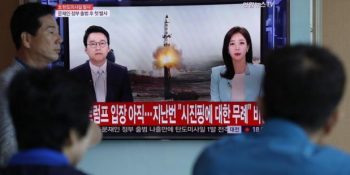SEOUL – North Korea on Sunday test-launched a ballistic missile that flew as far as 800 kilometeres before landing in the Sea of Japan, the South Korean, Japanese and US militaries said.
The launch is a direct challenge to the new South Korean president elected four days ago and comes as US, Japanese and European militaries gather for joint war games in the Pacific.
It wasn’t immediately clear what type of ballistic missile was launched, although the US Pacific Command said that “the flight is not consistent with an intercontinental ballistic missile.”
Outside militaries will closely analyse what the North fired. While Pyongyang regularly tests shorter-range missiles, it is also working to master the technology needed to field nuclear-tipped missiles that can reach the US mainland. Past North Korean missiles have flown farther than 800 kilometres in tests, landing closer to Japan, but this launch follows a series of high-profile failures.
Whatever the type of missile, the launch forces the new South Korean leader, Moon Jae-in, to put dealing with Pyongyang, at least for now, above the domestic economic agenda he’d made a priority during his early days in office.
Moon, a liberal who favours a softer approach to the North than his conservative predecessors, called an emergency national security meeting on Sunday, but he didn’t immediately make any statement on the launch.
Japanese Chief Cabinet Secretary Yoshihide Suga said the missile flew about 800 kilometres from a launch site on North Korea’s western coast for about 30 minutes and landed in the Sea of Japan, but not inside Japan’s exclusive economic zone. Prime Minister Shinzo Abe told reporters on Sunday that the launch, which is banned by the United Nations, is “absolutely unacceptable” and that Japan will respond resolutely.
South Korea’s Joint Chiefs of Staff said in a statement said that the missile was fired early Sunday morning from near Kusong, in North Phyongan province.
North Korea’s past satellite rocket launches have been called clandestine tests of ICBM technology, but it is not believed to have tested a true intercontinental ballistic missile yet. The Trump administration has called North Korean ballistic and nuclear efforts unacceptable and has swung between threats of military action and offers to talk as it formulates a policy.
The North’s state media said on Saturday it will bolster its nuclear capability unless the United States abandons its hostile policy.
“The United States should never expect us to give up our nuclear capability,” the main Rodong newspaper said in a commentary carried by the Korean Central News Agency. It said US President Donald Trump’s “maximum pressure and engagement” policy is only aimed at “stifling us” and will compel the North to “strengthen our nuclear deterrent at the maximum speed.”
The launch also comes as troops from the US, Japan and two European nations gather on remote US islands in the Pacific for drills that are partly a message to North Korea. The USS Carl Vinson, an aircraft supercarrier, is also engaging with South Korean navy ships in waters off the Korean Peninsula, according to Seoul’s Defence Ministry.
Last week South Koreans elected Moon to replace conservative Park Geun-hye, who is in jail awaiting a corruption trial. North Korea needs tests to perfect its missile program, but it also is thought to stage its launches after the elections of new US and South Korean presidents in an attempt to gauge a new administration’s reaction.
Moon, the first liberal leader in Seoul in nearly a decade, said as he took his oath of office that he’d be willing to visit the North if the circumstances were right. Trump has also said he’d be “honoured” to talk with leader Kim Jong-un under favourable conditions.
On Saturday, a top North Korean diplomat in charge of US relations, Choe Son-hui, told reporters in Beijing that Pyongyang would be willing to meet with the Trump administration for negotiations “if the conditions are set.”
During the South’s so-called “sunshine” era of the late 1990s and early to mid2000s, liberal South Korean leaders held two summits with Kim Jong-un’s father, the late Kim Jong-il, and shipped huge amounts of aid to the North. Critics say this only helped the elite in Pyongyang build their missile and nuclear programs, while supporters point to the bloodshed, threats of war and nuclear development of the last decade as proof that the conservative approach was no better.
Moon has moved more quickly on domestic economic goals than foreign policy. But analysts say that North Korea’s weapons programme is likely too far advanced for him to be able to return to the type of sunshine policies his liberal predecessors favoured.
